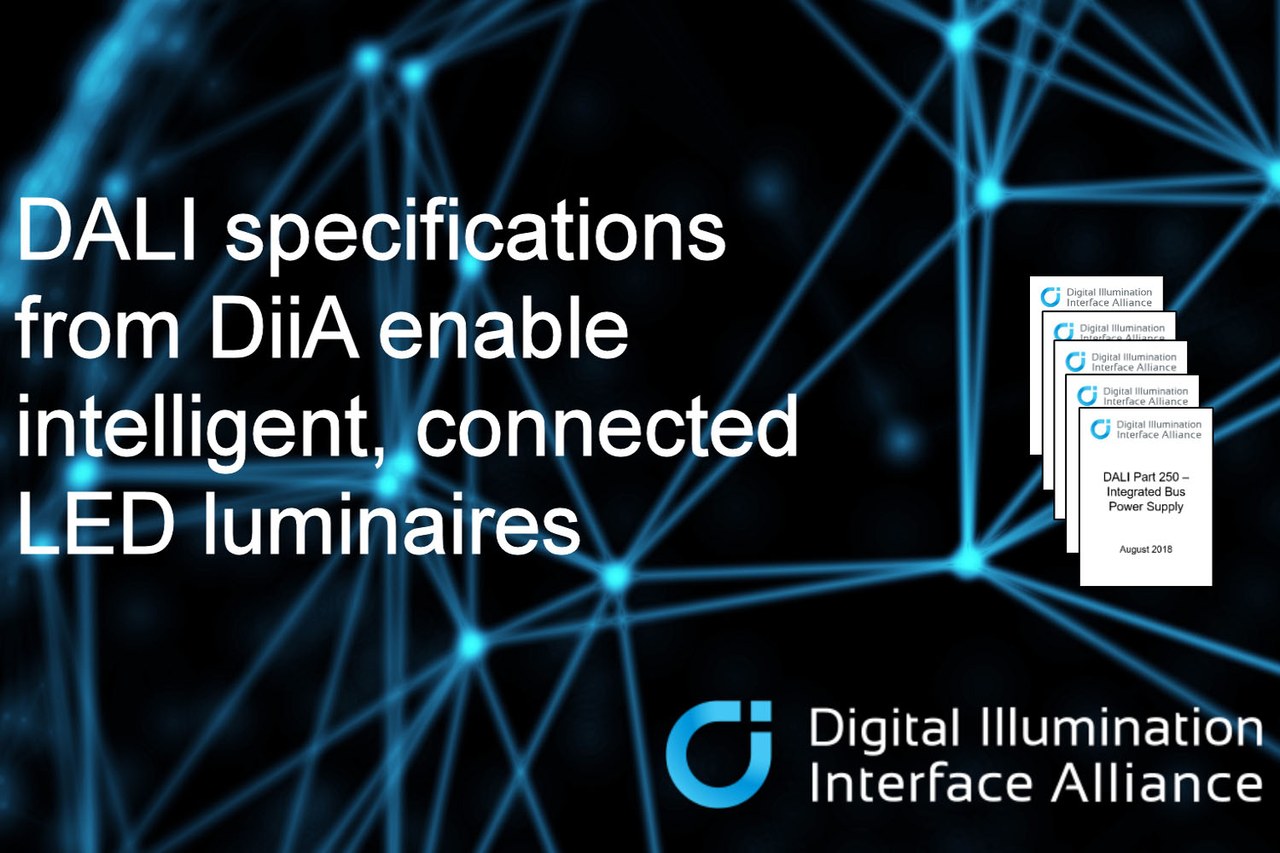DALI Specifications from DiiA Enable Intelligent, Connected LED Luminaires
New specifications from DiiA enable smart DALI drivers that can report data, supporting DALI in the IoT era, and can also simplify the addition of sensors and communication nodes to luminaires via an intra-luminaire DALI bus.
Addressing the market need for intelligent lighting fixtures with sensing and communication capabilities and IoT connectivity, the Digital Illumination Interface Alliance (DiiA) has finalized a set of new specifications based on the DALI lighting-control protocol.
The specifications enable smart LED drivers and luminaires that can report operational, diagnostic and inventory data. Also, the specifications simplify the addition of sensors and wireless-communication nodes (also known as network lighting controllers) to luminaires by taking care of power-supply requirements. In turn, this makes it more straightforward for luminaires to participate in the IoT.
DiiA is the global industry alliance for DALI lighting control, and the five new DiiA specifications build on DALI-2, with its strong focus on multi-vendor interoperability. DiiA has worked with other organizations, notably the American National Standards Institute (ANSI), to ensure global alignment of the specifications.
Specification details:
One of the new DiiA specifications (known as Part 251) focuses on luminaire-specific data for asset management and other purposes. This would allow a manufacturer to encode data about the luminaire – such as part number, or nominal light output – in the factory. When the luminaire is installed, the data is readily available to the lighting-control network. A utility company or lighting-installation owner could use this capability to monitor and manage their lighting assets accurately and efficiently.
Two specifications (Parts 252 and 253) enable smart DALI-2 drivers that can store and report operational and diagnostic data in a standardized format. For example, the driver could monitor and report its energy usage, total operating time, and incidences of thermal shutdown, as well as many other parameters.
Two further specifications (Part 250 and AUX) focus on power-supply requirements for DALI devices in luminaires. Devices such as sensors or wireless-communication modules are powered by the DALI driver via an intra-luminaire DALI bus. Where necessary, an auxiliary power supply is also specified. As well as simplifying the addition of such DALI devices to luminaries, this opens the possibility for the luminaire to participate in the IoT and to communicate and exchange data with a remote network infrastructure.
More details about DiiA’s new specifications are available on the DiiA website: www.digitalilluminationinterface.org/specifications
Harmonization:
One impetus for DiiA’s work was harmonization of different approaches, creating an open market to enable choice for OEMs. A variety of solutions have already been implemented by different suppliers, including drivers that simplify the connection of sensors to luminaires.
In developing the specifications, DiiA worked with the ANSI Accredited Standards Committee (ASC) C137 on Lighting Systems. The ANSI committee provided feedback on the draft DiiA specifications, and forthcoming ANSI standards in this area will be aligned with the DiiA specifications, including the proposed ANSI standard C137.4, entitled “Digital Interface with Auxiliary Power”.
“The close cooperation between ANSI ASC C137 and DiiA is enabling development of specifications that will address stakeholder needs and have global relevancy by aligning with the DiiA specifications,” said Mike O’Boyle, Technical Coordinator of the proposed ANSI C137.4 Working Group.
In due course, DiiA will provide the new specifications to IEC for incorporation into IEC 62386, the international DALI standard. Also, DiiA will create test sequences for the new specifications, enabling their incorporation into the DALI-2 certification program.
About DiiA:
The Digital Illumination Interface Alliance (DiiA) is an open, global consortium of lighting companies that aims to grow the market for lighting-control solutions based on Digital Addressable Lighting Interface (DALI) technology.
DiiA operates the DALI-2 certification program, based on version 2 of the international IEC 62386 standard. DALI-2 certification brings the promise of significantly improved interoperability and additional functionality compared with current DALI systems in the market.
DiiA develops test sequences that enable its members to verify compliance of their products with the DALI-2 standard. DiiA is also developing new specifications for additional features and functions of DALI-2 products.
DiiA is a member program of the IEEE Industry Standards and Technology Organization (ISTO). For more information, please visit www.digitalilluminationinterface.org

